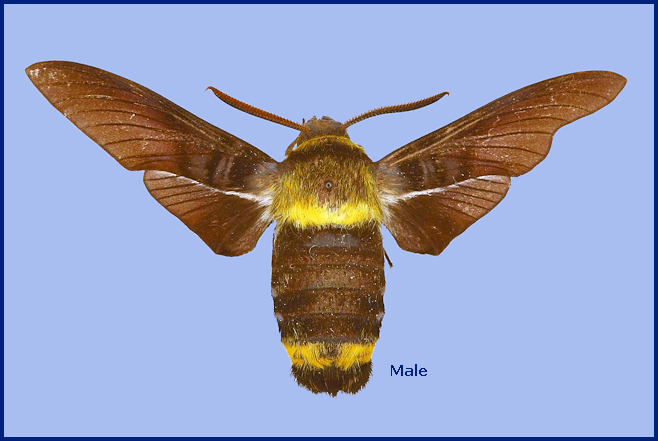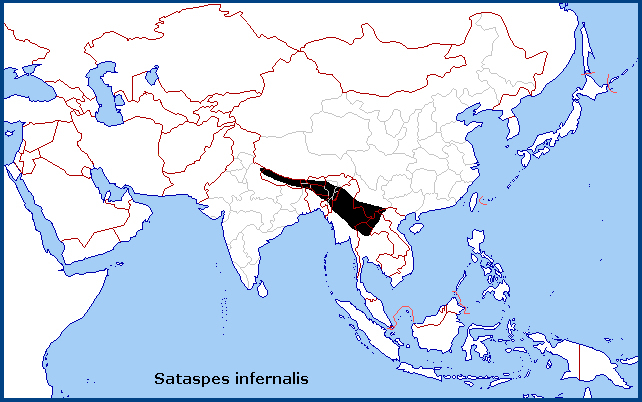
Sesia infernalis Westwood, 1847, Cabinet. Orient. Ent.: 61. Type locality: [Bangladesh,] Silhet [Sylhet].
Synonym. Sesia infernalis Westwood, 1847.
Synonym. Sataspes uniformis Butler, 1875.
Note. Transferred to Sataspes by Moore, [1858] 1857, Cat. lepid. Ins. Mus. East India Company 2: 261. The name infernalis also applies to the 'standard' form in which the abdomen has a more-or-less broad yellow band on tergites 6 and 7. In f. uniformis (Butler, 1875), the abdomen bears few or no yellow scales.
Note. Following recent work by Brechlin & Kitching (2009), it has been found that specimens hitherto treated as Sataspes infernalis sensu auctorum belong to two species: Sataspes infernalis sensu stricto (including Sataspes uniformis Butler, 1875 as a junior synonym) and Sataspes xylocoparis Butler, 1875.
Note. Sataspes (infernalis) f. glossatrix (Rothschild & Jordan, 1903) from Kalimantan, Borneo, is a synonym of Sataspes javanica Roepke, 1941.
Wingspan: 56--70mm. Thorax upperside yellow, except a black, ill-defined, transverse band anteriorly on mesonotum; sometimes centre of thorax more or less black. Abdomen upperside with a more or less broad yellow band on sixth and seventh tergites in most individuals; the other tergites generally with dispersed yellow hair scales. Abdomen underside with posterior sternites yellow only at sides. Discs of wings violet-purple, with little gloss; however, the forewing upperside fades to brownish soon after death. Hindwing underside with a white patch at base (Bell & Scott, 1937). In the male genitalia, uncus with the lobes compressed, pointed, slightly curved downwards, somewhat sabre-shaped, upper edge rough with notches near middle. Harpe with lobe truncate, the ventral edge acuminate, tooth pointed, plate large.
Variable, with some named forms, often from the same brood. A mimic of large bees, particularly species of Xylocopa (carpenter bees), with male and female moths mimicking different species of bee.
![A plate from Boisduval, [1875]. A plate from Boisduval, [1875].](bois1875.jpg)
A day-flying moth which is attracted to flowers, but usually only up until 10.00h. Frequents woodland margins and shady tracks through woodland, particularly near bodies of fresh water.
China: 11.iv (Yunnan); 21-23.vi (Yunnan).
OVUM: Pale green, slightly oval (1.2 x 1.0 x 1.0mm), smooth and shiny (Bell & Scott, 1937).
LARVA: Full-fed 60mm, width 11mm. According to Bell & Scott (1937), in the first instar head round, body cylindrical, horn straight and minutely bifid; head covered with hairs, some simple and some forked; body with a transverse row of small tubercles on each secondary ring, each tubercle with a forked hair; colour of head yellowish, body pale green, horn black. In the second instar the head becomes triangular, with a short process rising from the apex of each lobe; tubercles and hairs as in first instar; colour of head green, the processes rusty-pink, and with a narrow yellow cheek stripe; body green with faint oblique lateral stripes. The third and fourth instars show little change.
The final instar is pale glaucous green, darker ventrally, with six whitish/yellowish, oblique lateral stripes, the one associated with the horn being bolder than the rest. In some there is a diamond-shaped pale- or reddish-brown patch dorsally on abdominal segments 3-4, flanked by larger patches; further small patches may occur just anteriorly to this and on abdominal segment 6. Body tapering gently from segment 8 to 2 and from 8 to 12, the second about as broad as head. Head large, triangular, with rounded vertex and no processes. Surface of head shining, shallowly rugose, the cheek-stripe set into small tubercles. Spiracles yellow with white slits. Horn short and stout, slightly down-curved, tapering evenly to a sharp point.
The young larva rests in a typical sphinx-like attitude. When molested it exudes a brownish juice copiously from the mouth. The frass is peculiar, consisting of pieces of leaf held together loosely (Bell & Scott, 1937).
PUPA: 35mm. Colour dark red-brown to nearly black; head, thorax, wing-cases and anal segments nearly black, spiracles red-brown. Head rounded, body broadest about the middle; frontal ridges similar to those found in Marumba, roughly parallel, close together, the inner face of each ridge nearly vertical, the outer gently sloping. Surface shining, head, thorax and wing-cases coarsely lined in a manner resembling cracked lacquer; the frontal ridges coarsely pitted and wrinkled; abdomen deeply and coarsely pitted, especially on the anterior half of each segment dorsally and ventrally; sculpturing on segment 4 consisting of a narrow, median, transverse weal on each side of the dorsal line, each weal outlined by a deeply depressed line; ante-spiracular ridges on 9 to 11 consisting of three narrow ridges separated by wide channels. Spiracle of segment 2 a wide slit with narrow raised edges; of remaining segments oval, the surface rising to the central slit with narrow raised edges. Cremaster an equilateral triangle coarsely pitted, ending in a short, stout, shortly bifid shaft (Bell & Scott, 1937).
Pupation takes place in a cell a short depth below the surface, or in a rough cocoon on the surface.
Larval hostplants. In India on Dalbergia volubilis Roxb., and in China on Albizia lebbeck (L.) Benth. and Lespedeza (Bell & Scott, 1937).
Unknown.
China: Yunnan (Xishuangbanna, Mengla County, 870m; Lincang, Nangun River National Nature Reserve, 1700m; Kunming, Shilin County, 1600m).
Northern India (Uttarakhand, West Bengal, Sikkim), Nepal, Bhutan (Irungbam & Irungbam, 2019), northeastern Bangladesh, northern Myanmar/Burma, southern China (Yunnan (Jiang, Lou & Zhang, 2021)), northern Thailand and northern Vietnam.

 Return to Sphingidae of the Eastern Palaearctic species list
Return to Sphingidae of the Eastern Palaearctic species list